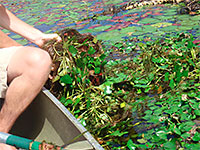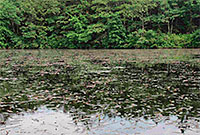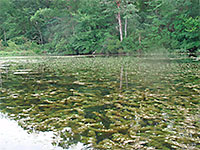Website content other than annual reports last updated May 31, 2013.
Learn More!
- RI DEM Introduction to Aquatic Invasive Species
- RI Marine & Estuarine Invasives Species website
- Rhode Island Freshwater Lakes and Ponds - Aquatic Invasive Plants and Water Quality Concerns (pdf)
- RI CRMC Marine Invasive Species
- Mass Audubon: Invasive Species in Massachusetts
- Boat: Massachusetts. Invasive species
Data Sources:
- RI DEM Aquatic Invasive Species
- MA DCR Aquatic Invasive Species
- RI Invasive Species Council
- USDA Map for RI
- USDA Map for Ma
Posters:
- 2012 Assessment Poster (pdf)
- 2011 Assessment Poster (pdf)

Invasive Species
When plants or animals are released in areas outside their native range, without their natural predators, they can grow and reproduce out of control, destabilizing the environment and harming native species and human activities. They become "invasive species."
Aquatic invasive plants are a widespread problem in RI freshwater lakes. A 2012 RI DEM report reviewed information on aquatic invasive species in 133 Rhode Island lakes and found that 80 lakes are infested with one or more invasive plant. A total of 13 different species have been detected with variable milfoil and fanwort being the plants most commonly found. Aquatic invasive plants create dense vegetative growth that interferes with the desirable uses of lakes and has been documented by researchers to reduce lakeside property values. The occurrence of aquatic invasive plants in Rhode Island lakes is similar to that documented in neighboring Connecticut and Massachusetts.
Rhode Island has an aquatic invasive species management plan developed by CRMC, RIDEM, and federal and private partners and approved in 2007. State, federal, and private CRMC. Nonetheless, the plan is not fully implemented and Rhode Island continues to struggle with the significant and growing threat of aquatic invasive species to its environmental resources.
Freshwater and Terrestrial Invasive Species: 2012 Assessment
Status and Trends: Many invasive species are already here, and only a few of them are being tackled adequately to limit or reverse their damage. Non-native species will continue to make their way to Rhode Island, with the potential for some to become invasive.
Management: Rhode Island needs to be vigilant to catch new invaders early and develop effective long-term management strategies for invaders that are already well established.
Freshwater and Terrestrial Invasive Species: 2011 Assessment
Status and Trends: Many invasive species are already here, and only a few of them are being tackled adequately to limit or reverse their damage. Non-native species will continue to make their way to Rhode Island, with the potential for them to become invasive.
Management: Rhode Island needs to keep informed, be vigilant and have plans ready to respond when needed. Successful public and private efforts to date could be even more effective with consistent state funding of key capacities, particularly coordination and communication, training, and early detection and rapid response.
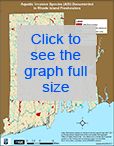
In Rhode Island, freshwater invasives have been found in over 80 lakes and ponds. This map shows the lakes in Rhode Island that have been surveyed and which ones have been found to contain invasive species.
Workshop Documents (in Adobe Acrobat format)
Januray 12, 2012 Workshop to Select Target Species
- Agenda
- Summary Report
- Invasive Species Metrics, a presentation by Hope Leeson (RINHS)
December 15, 2010 Workshop
- Agenda
- Summary Report
- Invasives indicators used by other programs by Lesley Lambert (NBEP)
- Definition of invasive species by Hope Leeson (RINHS)
- Examples of invasive species: Japanese stiltgrass, Kudzu by Hope Leeson (RINHS)
- Forest Health Works Project and Japanese barberry by James Barnes (FHWP)
- Emerald Ash Borer by Lisa Tewksbury (URI Bio Control Lab)
- Aquatic Invasive Species by Evan Ross (RIDEM OWR)
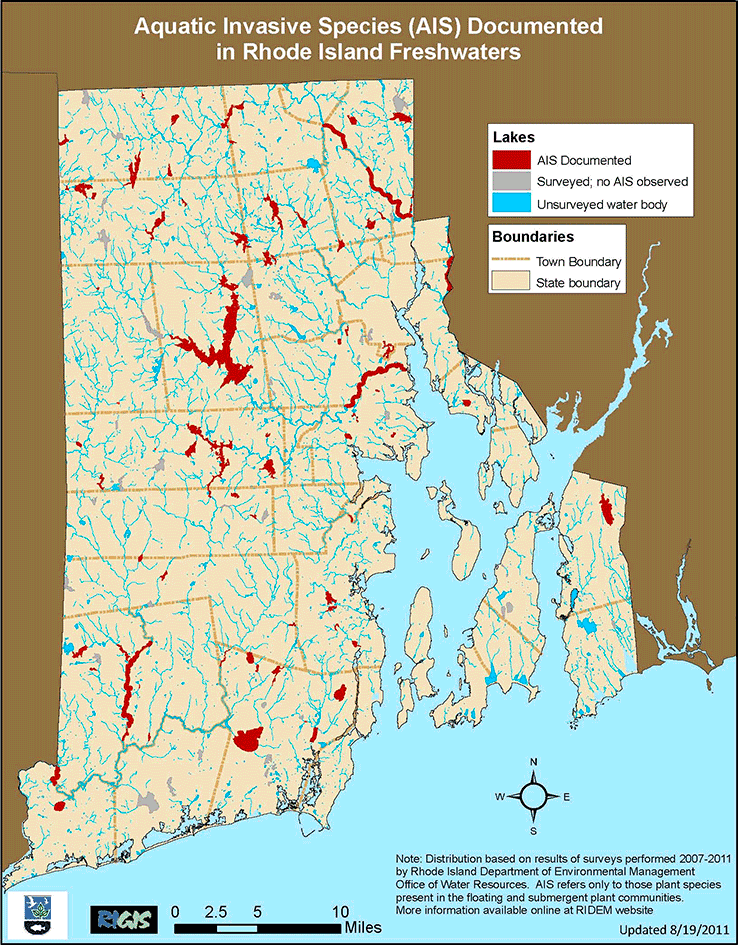
Rhode Island Department of Environmental Management
